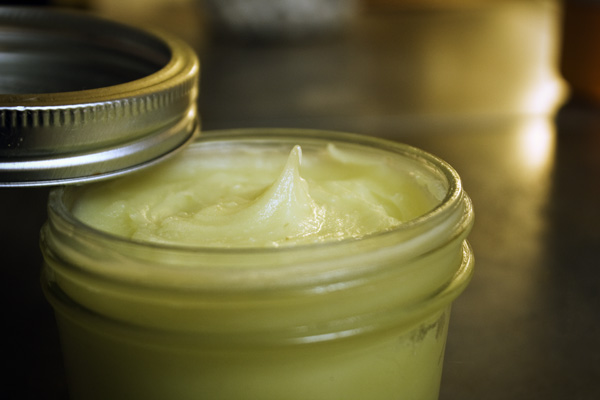When I grew up my mother and father seemed to have a salve for everything (which we pronounced ‘sav’). When I and my siblings fell over, they applied a healing salve. If we had chest infection, my mother would rub a menthol-based salve into our chest, opening our nasal passages and allowing us to sleep better. Salve has become number one in our cabinet of medicines.
Salves originate from a simple base recipe with ingredients added as per the need. From the base, you can make a salve for almost any topical medicinal use. This article will teach you how to build a base for salves and how to infuse herbal oil. The salve that we will make in this case is used for cuts and wound healing. The article will also mention other possible ingredients you can create when you master this simple salve recipe for other salves.
Preparing an Infused Herbal Oil
Many types of herbs and plants can be used as the active ingredients in a salve. In this recipe, I have chosen plants that are good for cuts and small wounds.
The recipe includes the following ingredients:
- Thyme: Thyme contains ‘Thymol’ which is an antiseptic and often used to medicate wounds and bandages to prevent infection.
- Lavender: As well as making the salve smell good, lavender is known to have antimicrobial and anti-inflammatory action.
- Comfrey: This plant, both the root and the leaves and flowers, has been used since ancient times to help wounds to heal. It can help to slow down the bleeding and has anti-inflammatory action.
NOTE: never use a salve on a dirty wound, always clean the area thoroughly first.
Related: The Hidden Secret of Shepherd’s Purse
Preparing the Plants for Salve Use
There are two basic methods for preparing the plant extracts, to create an infused oil, for use in a slave base:
Quick and easy method: Double boiler method of extraction of herb active ingredients into oil
Ingredients:
- Dried Thyme
- Dried Lavender
- Dried Comfrey (use the leaves and flowers from the plants)
- Olive oil or nut oil
- Double boiler
- Something to strain the oil (cheesecloth or similar)
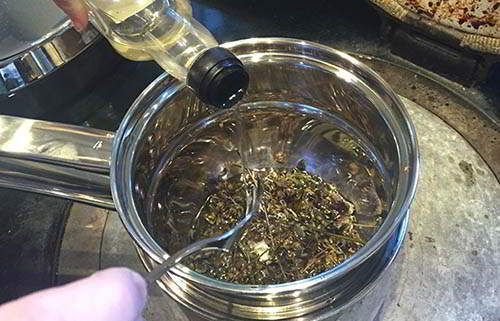
Making the Infused Oil
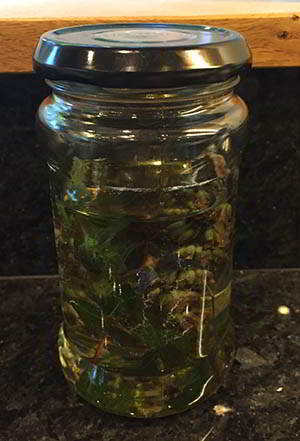 Place your mix of dried herbs into the double boiler (as shown above). Cover the herbs with oil so there is about 1 inch of oil covering the top of the herbs. If you shred or grind the herbs up, you’ll increase the surface area and so improve extraction of the active ingredients.
Place your mix of dried herbs into the double boiler (as shown above). Cover the herbs with oil so there is about 1 inch of oil covering the top of the herbs. If you shred or grind the herbs up, you’ll increase the surface area and so improve extraction of the active ingredients.- Using a low heat, warm the oil and herbs for 1-5 hours, until the oil turns the color of the herbs. If you have a ‘warming oven’ (typically used in bread making) you can leave the mix of oil and herbs in a glass proof bowl in that oven for around 48 hours. This will also extract the active ingredients from the plants.
- Strain the oil to remove any plant debris. Be careful as the oil will be hot
- Keep the herb infused oil in a jar in a cool place ready for salve making
NOTE: If you don’t have a double boiler you can instead use a heat proof glass bowl on a pan of water – be careful not to overfill the pan as the water, when boiling makes the glass bowl ‘jump’.
Slow Method:
Collected herbs in jar – using in-direct sunlight to extract the active ingredient into oil
Ingredients:
- Dried Thyme
- Dried Lavender
- Dried Comfrey (use the leaves and flowers from the plants)
- Olive oil or nut oil
- Jar with tight lid
- Something to strain the oil (cheesecloth or similar)
- Some sunshine
Making the Infused Oil
- Place the dried herbs, either chopped or loosely shredded into the jar
- Pour the oil over the herbs covering them
- Leave in in-direct sunlight for around 3-4 weeks
- Every day give the jar a shake or two
- Once the oil starts to take on the color of the herbs and smells of lavender and thyme, it is time to strain
- Using the cloth, strain the oil until the plant debris is removed
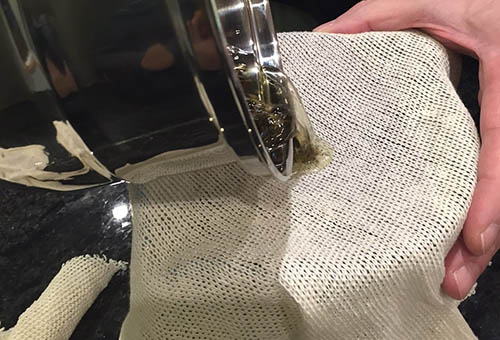
Strain the oil through cloth to remove the plant debris and leave clear oil
Related: Why You Should Put Garlic in Your Ear
How to Make a Salve Base
The salve base is the medium which holds the active ingredients. This is also the process used to spread and absorb these active ingredients on and through the skin to a certain degree. The salve is based on beeswax but other healthy waxes like Carnauba wax (palm wax) can be used as well.
Ingredients
- 4 oz of a herbal infused oil such as that described in the section “Preparing the Plants for Salve Use”
- 1/2 – 1 oz beeswax pellets (amount depends on how thick you want the salve to be)
- 10-20 drops of essential oils such as Tea Tree or lavender (optional)
- Double boiler (you can use a commercial one or a make-shift one as I have done below)
- Some tins or small glass jars to hold the salve
Making the Salve Base Using the Infused Herbal Oil
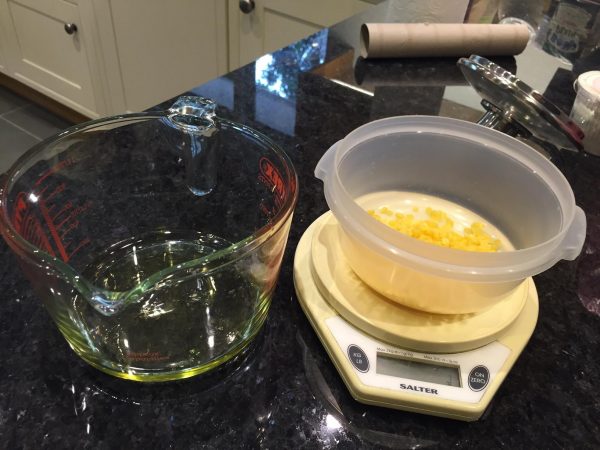
4 oz infused oil ready: 1 oz beeswax pellets
- Place the beeswax pellets into the double boiler. Alternatively, use a heatproof glass bowl over a pan that contains water, in the same method you would use to melt chocolate. Be careful not to overfill with water as it will make the glass bowl ‘jump’.
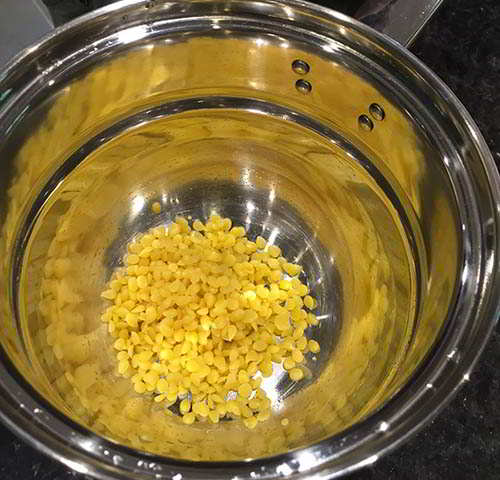
- Add the infused herbal oil to the softened beeswax and slowly heat and mix. You might find the wax starts to thicken when you add the cold oil, let it heat up and mix in the warmed oil/wax. Mix the melting beeswax using the handle of a wooden spoon or similar. Once the beeswax is completely melted, slowly add the infused oil to the melted wax in the double boiler. Mix as you pour. You’ll notice the wax starting to solidify as the colder oil hits it. Continue to heat and stir until the wax re-melts. Stir the two until completely mixed.
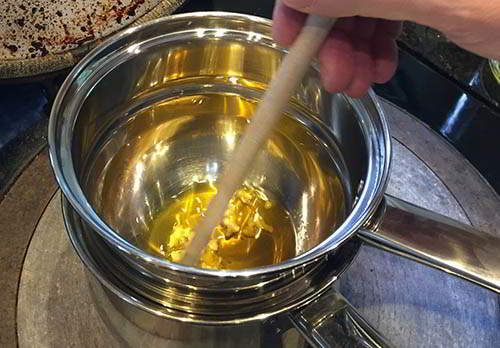
- Once thoroughly mixed, remove from the heat
- Allow to cool and then add in the essential oils (if using) and mix. I used a few drops of lavender oil in my mix at this stage
- Pour the cooled, but still soft, salve into your containers. Use a clean tin or glass jar.
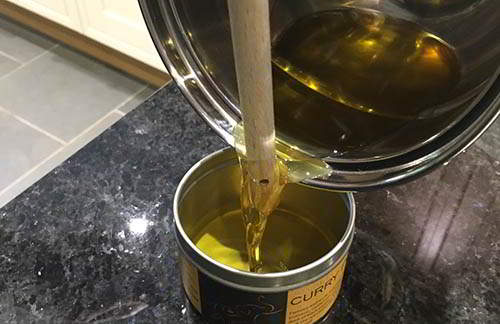
- Leave for about 15 minutes in a fridge or very cold place to harden the wax
- Use you salve on the clean-cut or wound or to add to bandages
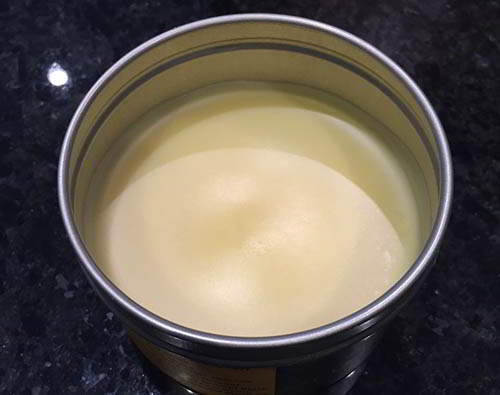
Other herbal / plant mixtures that can be used in salves:
- Menthol and peppermint: This combo is perfect for rubbing onto chests at night before sleep to help ease the symptoms of a cold or chest infection.
- Elderflower, Aloe, Lavender: Used in a salve for soothing sunburn.
- Calendula infused in coconut oil: Perfect for relieving eczema.
- Honey (preferably Manuka) used with coconut oil in the salve: For soothing burns.


